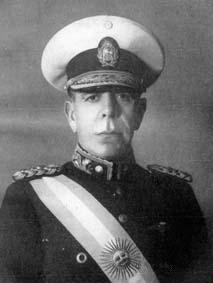| This article needs additional citations for verification. Please help improve this article by adding citations to reliable sources. Unsourced material may be challenged and removed. Find sources: "Edelmiro Julián Farrell" – news · newspapers · books · scholar · JSTOR (January 2013) (Learn how and when to remove this message) |
| Edelmiro Julián Farrell | |
|---|---|
 | |
| 28th President of Argentina | |
| De facto | |
| In office 9 March 1944 – 3 June 1946 | |
| Appointed by | Military junta |
| Vice President | None (Feb–Jul 1944) Juan Domingo Perón (1944–1945) Juan Pistarini (1945–1946) |
| Preceded by | Pedro Pablo Ramírez (de facto) |
| Succeeded by | Juan Domingo Perón |
| Vice President of Argentina | |
| De facto | |
| In office 15 October 1943 – 24 February 1944 | |
| President | Pedro Pablo Ramírez |
| Preceded by | Sabá Sueyro (de facto) |
| Succeeded by | Juan Domingo Perón (de facto) |
| Personal details | |
| Born | (1887-02-12)12 February 1887 Lanús |
| Died | 21 October 1980(1980-10-21) (aged 93) Buenos Aires, Argentina |
| Resting place | Cementerio de la Chacarita Buenos Aires |
| Nationality | Argentine |
| Political party | Independent |
| Spouse | Conrada Victoria Torni (1919–1977) |
| Profession | Military |
| Signature |  |
| Military service | |
| Allegiance | Argentina |
| Branch/service | Argentine Army |
| Years of service | 1907–1946 |
| Rank | Major general |
Edelmiro Julián Farrell Plaul (Spanish: [eðelˈmiɾo faˈrel]; 12 February 1887 – 21 October 1980) was an Argentine general. He was the de facto president of Argentina between 1944 and 1946.
Farrell had a great influence on later Argentine history by introducing his subordinate Juan Perón into government and paving the way for Perón's subsequent political career.
Early life
He was born in 1887 in Villa de los Industriales (Lanús, Buenos Aires). He was the tenth son of Juan C. Farrell (1846–1887) and Catalina Plaul (1852–1917) and the grandson of Matthew Farrell (1803–1860) of County Longford, which was the family seat of the Farrell clan in Ireland as Lords of Annaly, and Mónica Ibáñez (1819–1867).
Military career
Farrell graduated from Argentine military school in 1907 as an infantry sub-lieutenant. He served in an Italian alpine regiment in Fascist Italy between 1924 and 1926. He then returned to Argentina.
After the 1943 coup, Farrell was promoted to brigadier general and became vice-president during the military government of General Pedro Pablo Ramírez, who had deposed President Arturo Rawson. He was simultaneously Minister of War. Farrell appointed Juan Perón as his secretary.
President
Ramírez named Farrell as president on 25 February 1944. Farrell appointed Perón as vice-president. After popular demonstrations in favour of Perón in 1945 made Perón the most influential and important man in the government, Farrell announced presidential elections for 1946, and Perón was elected. On 4 June 1946, Farrell was succeeded as president by Perón. Farrell had been his commander while Perón was a colonel.
Farrell declared war on Nazi Germany and the Empire of Japan on 27 March 1945 towards the end of World War II after pressure to get Argentina as part of the Allies after the Inter-American Conference on Problems of War and Peace.
Family
He married on 10 July 1921, to Conrada Victoria Torni (1 January 1895 – 16 August 1977), a teacher. They had three children: Nelly Victoria (born 1923), Jorge Edelmiro (1925–1950), and Susana Mabel (born 1930).
Death
A widower, he died in Buenos Aires in 1980.
In popular culture
Farrell, in the movie Evita, is portrayed by British actor Denis Lill.
References
- Caucino, Mariano (27 March 2020). "El día que la Argentina le declaró la guerra a Alemania" [The day Argentina declared war on Germany]. Infobae (in Spanish). Retrieved 26 September 2021.
- "Dictionary of Irish Latin American Biography > "Farrell, Edelmiro Julián (1887-1980)"". www.irlandeses.org. Retrieved 7 June 2023.
Sources
- Mendelevich, Pablo (2010). El Final. Buenos Aires: Ediciones B. ISBN 978-987-627-166-0.
External links
- Short Biography (Spanish)
| Political offices | ||
|---|---|---|
| Preceded bySabá Sueyro | Vice President of Argentina 1943–1944 |
Succeeded byJuan Perón |
| Preceded byPedro P. Ramírez | President of Argentina 1944–1946 |
Succeeded byJuan Perón |
| Heads of state of Argentina | ||
|---|---|---|
| May Revolution and Independence War Period up to Asamblea del Año XIII (1810–1814) | ||
| Supreme directors of the United Provinces of the Río de la Plata (1814–1820) | ||
| Unitarian Republic – First Presidential Government (1826–1827) | ||
| Pacto Federal and Argentine Confederation (1827–1862) | ||
| National Organization – Argentine Republic (1862–1880) | ||
| Generation of '80 – Oligarchic Republic (1880–1916) | ||
| First Radical Civic Union terms, after secret ballot (1916–1930) | ||
| Infamous Decade (1930–1943) | ||
| Revolution of '43 – Military Dictatorships (1943–1946) | ||
| First Peronist terms (1946–1955) | ||
| Revolución Libertadora – Military Dictatorships (1955–1958) | ||
| Fragile Civilian Governments – Proscription of Peronism (1958–1966) | ||
| Revolución Argentina – Military Dictatorships (1966–1973) | ||
| Return of Perón (1973–1976) | ||
| National Reorganization Process – Military Dictatorships (1976–1983) | ||
| Return to Democracy (1983–present) | ||
- Presidents of Argentina
- 1887 births
- 1980 deaths
- Leaders who took power by coup
- World War II political leaders
- Argentine anti-communists
- Argentine generals
- Argentine people of Irish descent
- People from Avellaneda
- People from Buenos Aires
- Vice presidents of Argentina
- Burials at La Chacarita Cemetery
- 20th-century Argentine politicians
